- User Interactions in Social Networks and their Implications
- Christo Wilson, Bryce Boe, Alessandra Sala, Krishna P. N. Puttaswamy, and Ben Y. Zhao
- EuroSys 2009
- Understanding Latent Interactions in Online Social Networks
- Jing Jiang, Christo Wilson, Xiao Wang, Peng Huang, Wenpeng Sha, Yafei Dai and Ben Y. Zhao
- IMC 2010
Today's Topic: User Interactions
Data Gathering Methodology
Crawling Facebook
- Complete BFS crawl of the 22 largest regional networks in 2008
- Facebook had ~67M total users, 66% of which belonged to a regional network
- Examples: London, Australia, Turkey, France, Toronto, NYC, etc.
- By default, full profile and friend list visible to other users in your region
- Dataset summary
- 10.6M total users, 408M total edges
- ~50% coverage of each region: could not crawl private users
- Gathered visible interactions as well as social edges
- Complete history of incoming wall posts and photo comments for each user
- Why couldn't we crawl outgoing interactions?
Crawling Renren
- Renren is the largest and oldest OSN in China
- Launched in 2005
- Today, boasts over 200 million users
- At the time (2009), Renren was virtually identical to Facebook
- Conducted two separate crawls of Renren
- First crawl: complete BFS crawl of Renren
- All friend lists are publicly visible, no way to make them private
- 42M total nodes, 1.6B total edges
- Second crawl: focused crawl of the PKU network
- We were able to make many accounts in the Peking University network
- By default, these accounts can view interactions of other PKU users
- Crawled 61K users (out of 100K possible)
- Complete history of wall posts, status updates, blog entries, photos/tags, etc.
- First crawl: complete BFS crawl of Renren
Gathering Latent Interactions
- Each user profile on Renren has a list of the 9 most recent visitors
- Unique source of data not available on other OSNs
- Challenge: how to gather continuous history of visitors to profiles?
- Revisit each profile at regular intervals and grab visitor list
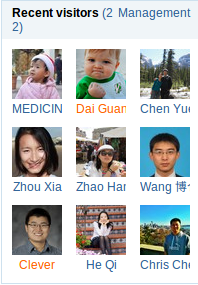
Sequencing Latent Interactions
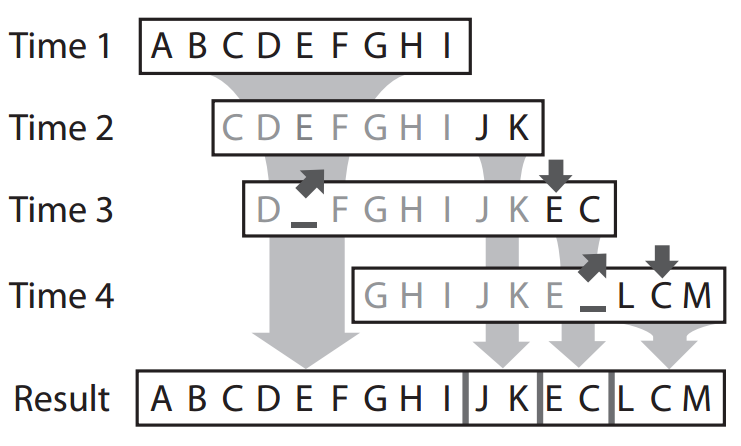
Prioritized Crawling
- Issue: visitor list only holds last 9 users
- Need to crawl frequently to avoid missed visits
- Limited HTTP requests per day
- Solution: build a prioritized crawler
- Visit popular users more frequently
- Most users can safely be crawled once per day
- Problem: how do we know we have captured all visitors?
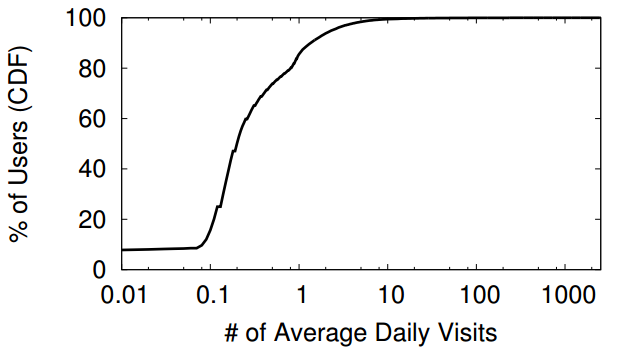
Validating the Methodology
- Experiment: crawl a subset of users every 15 minutes
- Extrapolate what visits would have been missed at different crawl frequencies
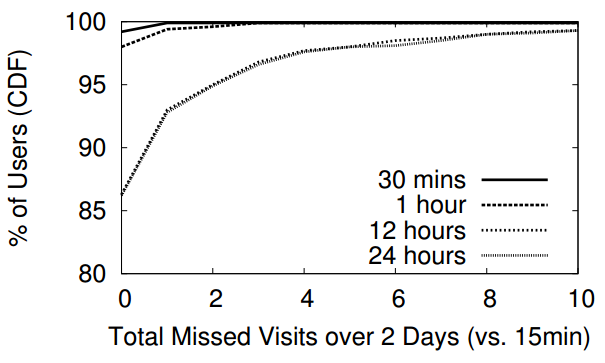
Social Graph Analysis
Degree Distribution
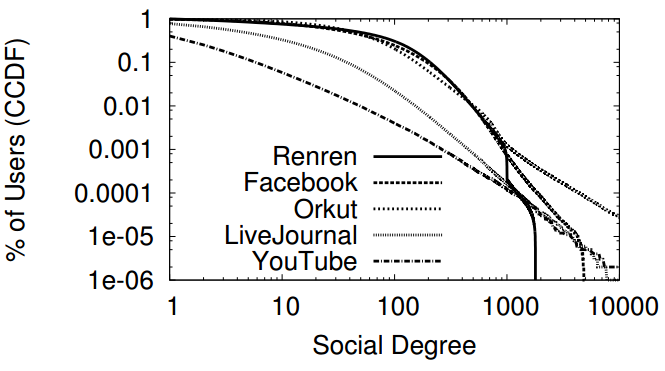
Clustering Distribution

Visible Interactions on Facebook
Interactions Over Social Graphs
- Analysis of visible interactions on Facebook
- Data drawn from wall posts and photo comments
- All interactions are incoming, e.g. friends who write on your wall
- Keep in mind: in 2008, there was no news-feed!
- Questions
- How are interactions distributed amongst your friends?
- Are all users equally interactive
- Is there a relationship between social degree and interactivity?
Interactions Over Friends
Q: How are interactions distributed over friends?
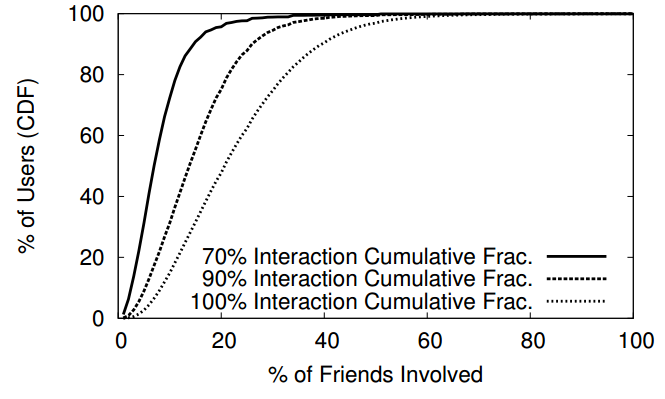
- A: Interactions are highly skewed towards a small number of friends
- Almost nobody interacts with >50% of their friends
Interaction Distribution
Q: Are some users more interactive than others?
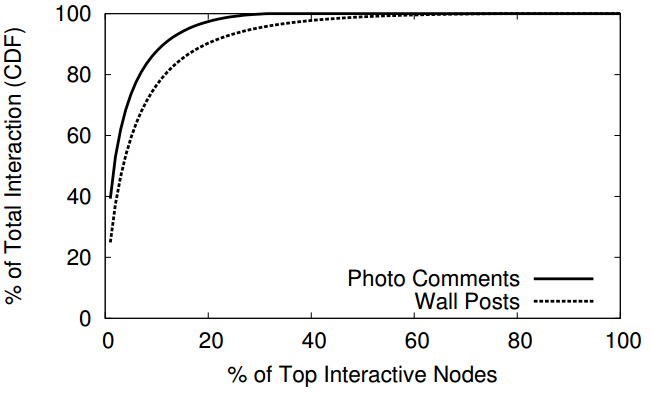
- A: Interaction distribution is highly skewed towards a small number of very active users
Interactivity vs. Social Degree
Q: Is there a relationship between social degree and interactivity?
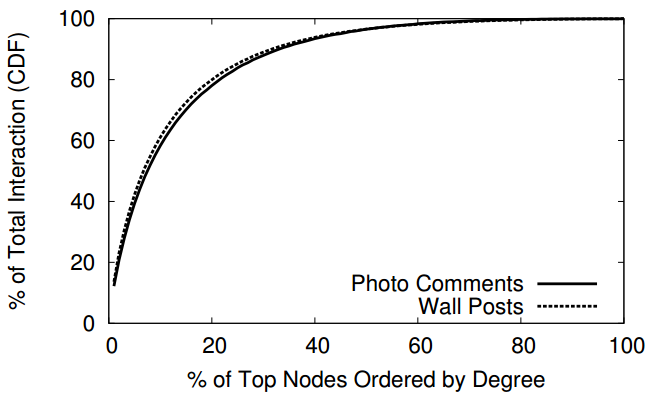
- A: High degree users are more likely to be highly interactive as well (positive correlation)
Latent Interactions on Renren
Profile Visits, Popularity, and Consumption
- Switching from Facebook data to Renren data
- Focus on latent interaction, i.e. profile visits
- Analysis of latent interactions
- How is popularity distributed?
- Is there a relationship between popularity and consumption?
- Who visits your profile?
- Comparing latent and visible interactions
Popularity Distribution
Q: How is popularity (total profile views) distributed?
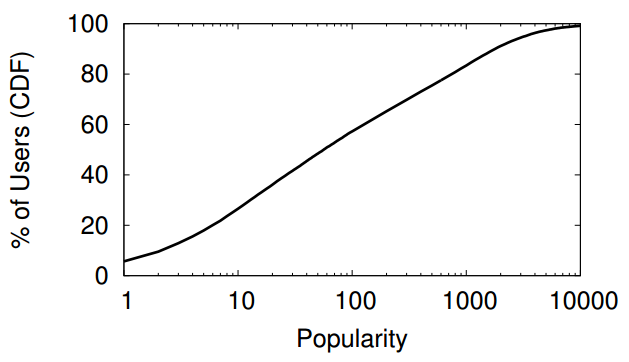
- A: Highly skewed distribution
- 60% of users receive <100 total profile views
Popularity vs. Consumption
Q: Are the users who receive the most visits also the users who do the most visiting?
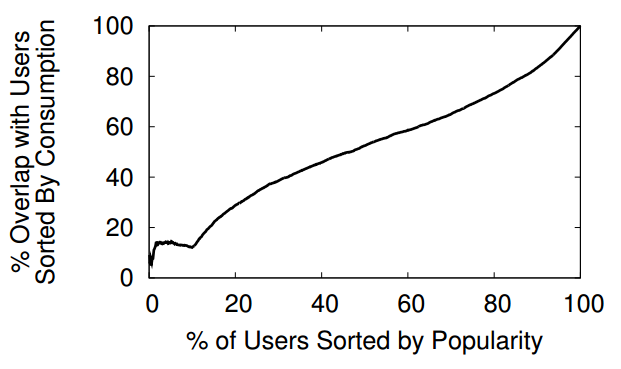
- A: In general, consumers are not highly correlated with popularity
- One exception: small contigent of extremely popular and active users
Repeat Profile Visits
Q: How many profile visits come from repeat visitors?
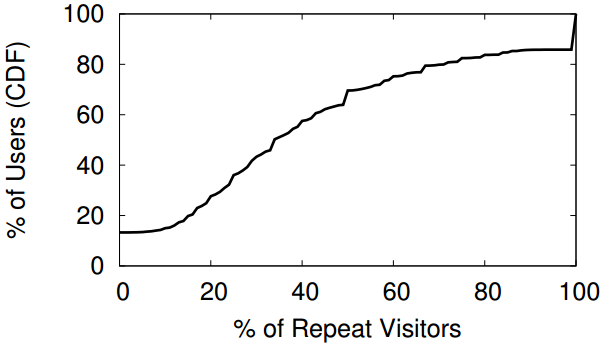
- A: 70% of users have <50% repeat visitors
- One exception: 10% of users have 100% repeat visitors
Reciprocity of Profile Views
Q: If you visit someones profile, will they visit you back?
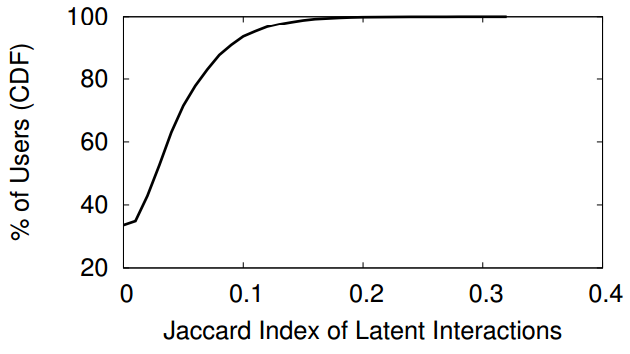
- A: Latent interactions are not reciprocal
- Surprising result, since Renren users can see who has visited their profile
Visitor Composition
Q: Who is browsing profiles: friends, fofs, or strangers?
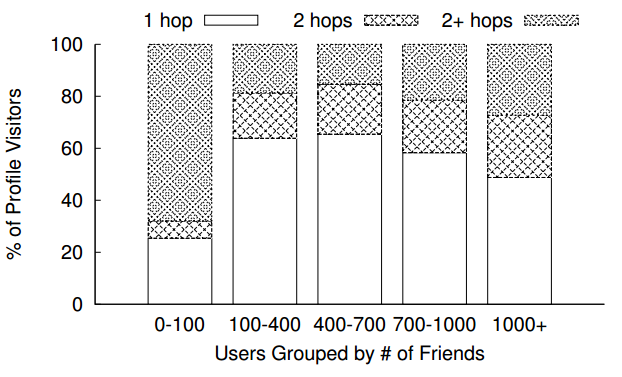
- A: Around 20% of visits come from fofs, and 20% come from strangers
- Disturbing finding: most people don't consider all the strangers browsing their profile
Interactions Over Friends
Q: How are interactions distributed over friends?
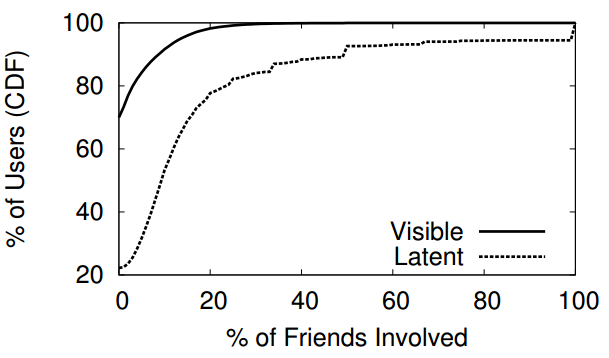
- Like FB, Renren users receive visible interacts from <30% of their friends...
- However, users receive latent interactions from many more friends
Interaction Distribution
Q: Are some users more interactive than others?
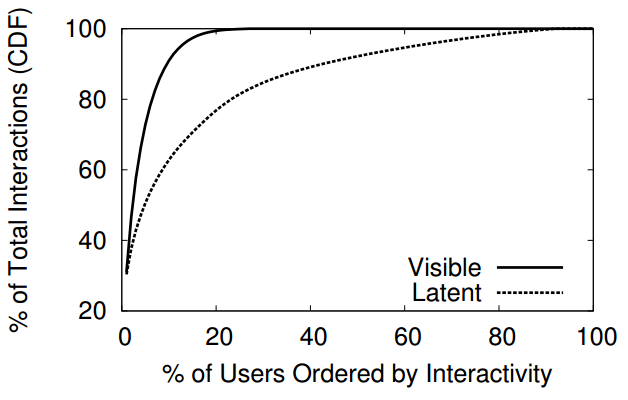
- A: Latent and visible interactions are both skewed...
- ...but latent interactions are much less skewed (i.e. more people generate them)
Interaction Graphs
Limits of Social Graphs
- Existing work focuses on social graphs, assumes all edges are equally important
- Clearly, this assumption is not correct
- How does graph structure change if we focus on interactive edges?
- Methodology: construct new graphs where edges correspond to interactions
- Visible interaction graphs are a subset of the social graph
- On Facebook and Renren, you can only visibly interact with friends
- Latent interaction graphs are a partially-overlapping a superset of the social graph
- Recall: strangers (i.e. non-friends) can browse profiles
- Visible interaction graphs are a subset of the social graph
Constructing Interaction Graphs
- Parameters
- \(n\): minimum number of interactions necessary to form an edge
- \(t\): range of time during which interactions must have occured
- Directed vs. Undirected graphs
- Interactions are inherently directed
- For simplicity, we formulate visible interaction graphs as undirected
- >60% of visible interactions are reciprocated
- Formulate latent interaction graphs as undirect
- <30 of latent interactions are reciprocated
- Alternative construction: weighted graphs
Parameterizing Interaction Graphs
Q: How does the size of interaction graphs vary as the edge requirements change?
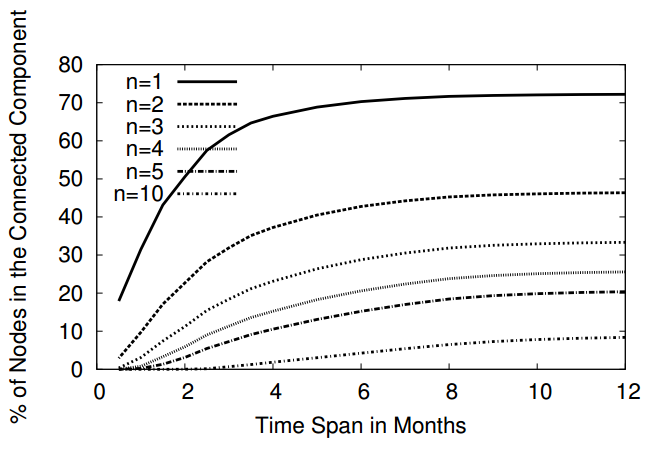
- A: As expected, more restrictive parameters drastically reduce the number of nodes in the SCC
Degree Distributions
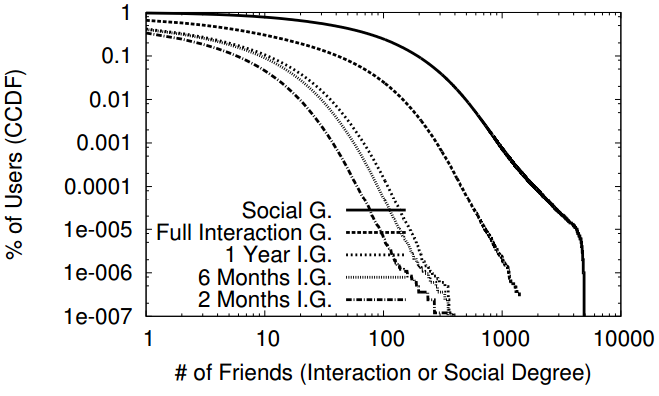
Interaction Graph Properties
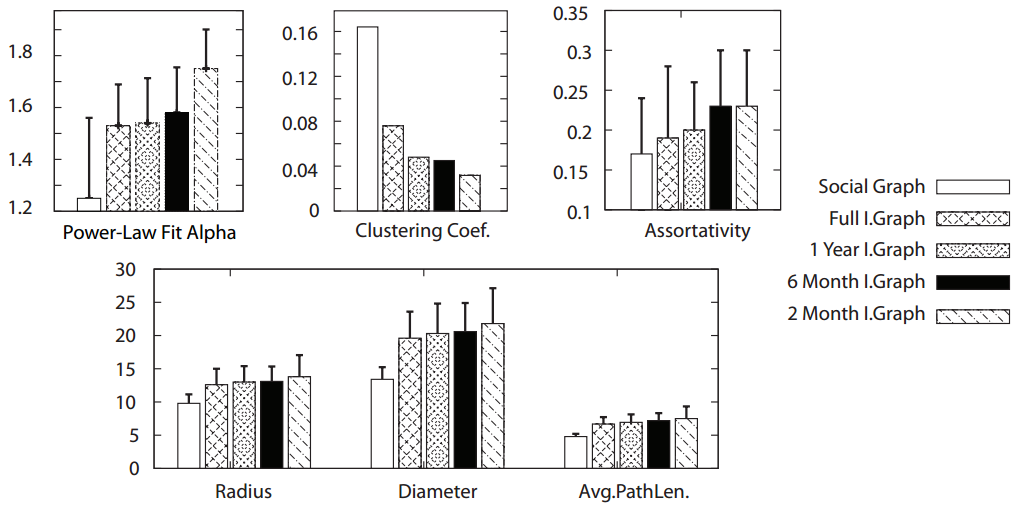
Interaction Degree vs. Social Degree
Q: What is the relationship between social and interaction degree?
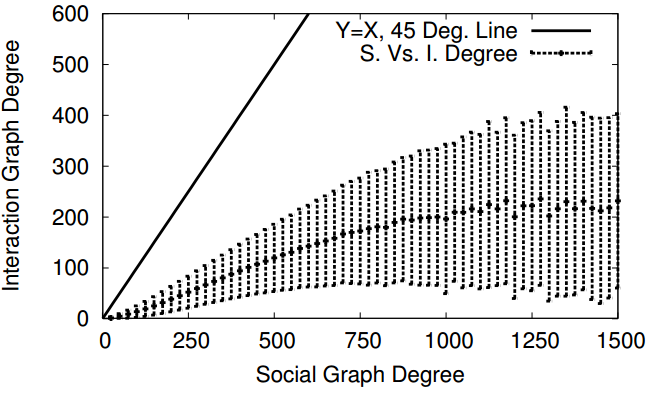
- Social friends are "free"; social degree essentially unbounded
- Interactions incur a cost; interaction degree is bounded
Latent Interaction Graphs
Q: How do latent interaction graphs compare to visible interaction and social graphs?
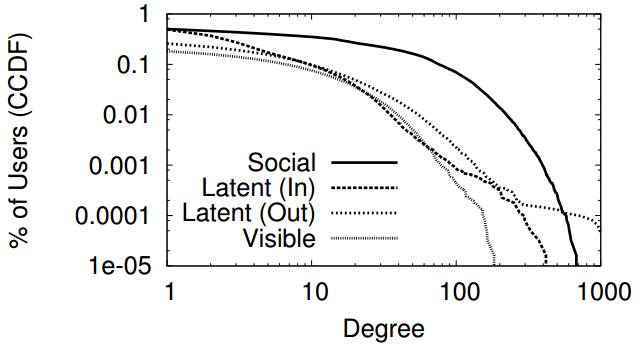
- A: Fall between the two; less edges than social graph, more than interaction
Clustering on Interaction Graphs
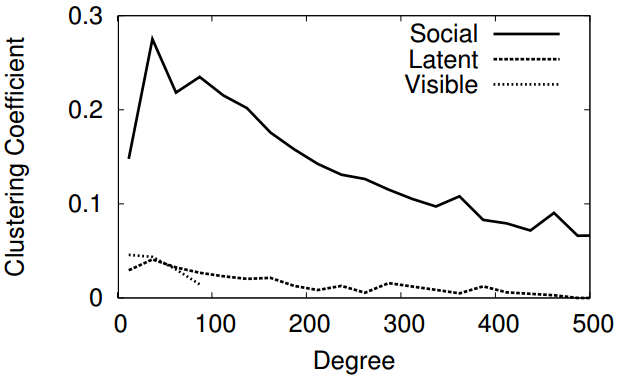
Resiliency and Core Size
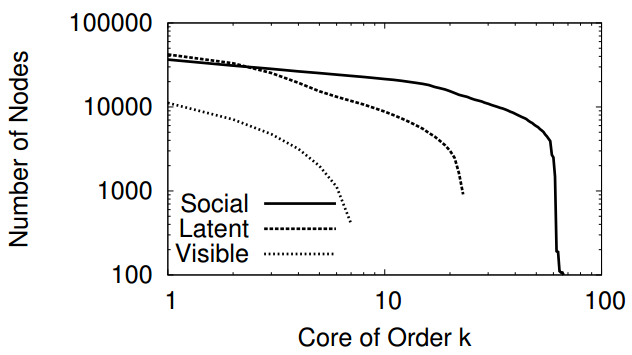
Discussion
- Why do we care about interactions on social networks?
- Which graphs are better: social or interaction graphs?
- What practical applications could leverage interaction graphs?
- This data is 4-5 years old. How might interaction graphs be different today?